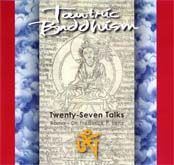
Tantric Buddhism
The Nexus of All Pathways
There are two ways to become enlightened - the easy way and the hard way.
I suppose that could be true of anything. The easy way is through a complete focus on that which is most positive. The hard way is through a focus on that which is negative. Both positive and negative come from the same source. So if you follow either path, the path of affirmation or negation, eventually you'll come to the source, if you follow them to the source.
But positive and negative, what we call yin and yang, light and dark, are circles. In the Far East, we look at life in terms of circles. In the West, they look at life more in terms of squares and rectangles. We look at life more as circles. In the West when you talk about yin and yang, people normally think of yin and yang as something that's linear. There's a single line, which is yin, and juxtaposed to it is a single line, which is yang. But in the East we tend to think of yin and yang as circles. They're two circles that actually can lie on top of each other, yet they remain separate. But if it's easier for you to think of it that way, you can think of them as being next to each other.
Now, yang, which is positive, affirmative, and so on, is a circle, and you can come into it at any point of the circle and go around the circle. When you've gone around the circle, at the end you'll come back to the beginning of the circle. And then you'll go around the circle again and again, forever. The same is true of yin. Being on the circle of yin or yang does not necessarily mean that you will ever go beyond the circle because the source of the circle is not necessarily connected to it.
To reach the source of the circle, you have to get off the circle. But going around the circle, one can build up a kind of a momentum, a speed. And as you go around the circle more and more rapidly, you can gain enough momentum so that you can lift above the circle and vortex, or do a pirouette, into the source of the circle. When you enter the source of the circles of yin and yang, it's what they call tai chi, the undifferentiated reality, which is a way of saying it's beyond description. But it is not something that can be separated - because what we're seeking is the nexus of all possible worlds and states of mind, which is within us. The source of yin and yang is within you.
But within us there are a number of different points or configurations where we come together and join as intelligence, as wakefulness, as something that has an aliveness to it. The points are progressions, the locus points, where the nexus that we are conjoins, creates what we call bonding reality structures, states of mind in a more vernacular usage. And these locus points cause perception.
Yin and yang are outgrowths, positive and negative. Affirmation and negation are negatives and positives; they're outgrowths, syntactical outgrowths of a nexus within the mind. But there is not one nexus within the mind. There are many. And self-discovery, the pathway to enlightenment - particularly the tantric method of attaining enlightenment and liberation and emerging into the clear light of reality, the dharmakaya, the rootless source of all being, the ultimate groundless ground, so to speak, what they would call God, nirvana - that assimilation, that jump, that trajectory, to move from the states of apparent reality, which we call the samsara, in which occur birth, growth, maturation, old age, death and rebirth - those circles are absorbed or are extensions of the mind. The mind is all that exists. There is nothing else. Everything that we perceive, including the action of pure perception, is an extension of the mind. Without the mind there is nothing.
The nexus of the mind, the central nexus, the first one you encounter, is that part of the mind that creates the pageant that you call life. The pageant of life is divided into yin and yang. They're two circles. You can follow either circle and manage to develop enough speed to move beyond this world or other worlds, dimensional realities. But the thing that the novice normally misses in all of this is that all states of mind are internal. That is to say, what creates reality is the mind's self-reflection.

